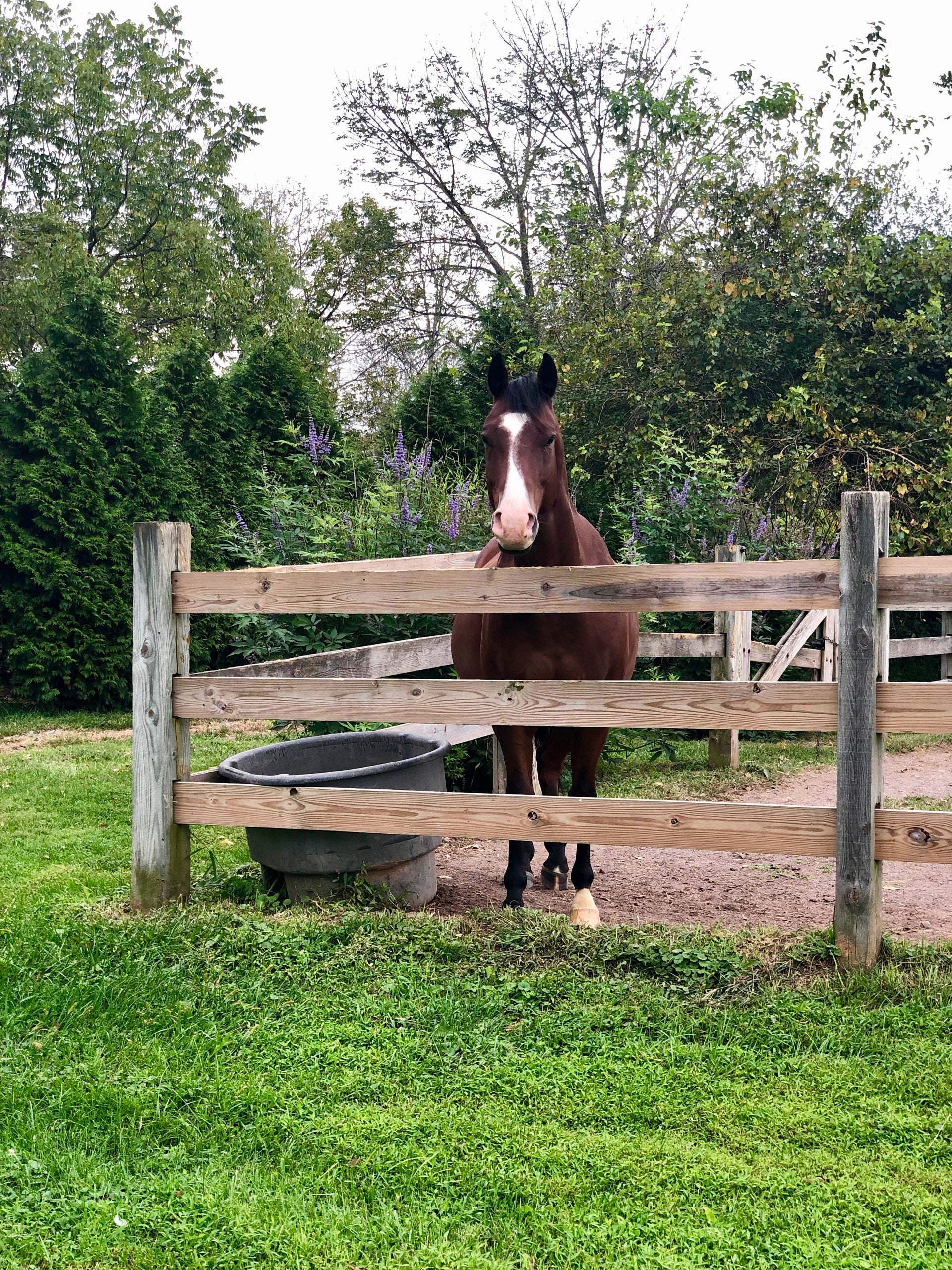The Equine Gut–Brain Connection: How the Mind Talks to the Microbiome
October 20, 2025

You might think of your horse’s gut as a digestion factory that takes feed in, and puts manure out, but the digestive system is far more complex and remarkable. In human medicine, the gut-brain axis has been a research hot topic, and in horses, this connection is also making its way into the limelight.
The gut-brain connection refers to the link and ongoing dialogue between the central nervous system and the enteric, or intestinal, nervous system through a network of microbes, which influence digestion, behavior, resilience, and even performance.
In this blog, we break down how this system works, signs that point to a gut-brain communication problem (Houston, do you copy?), and how to support the gut-brain axis in your horse.
The Gut Is Your Horse’s “Second Brain”
Your horse’s GI tract houses a dense network of neurons known as the enteric nervous system (ENS). Sometimes called the “second brain,” this system regulates gut motility, digestion, blood flow, and absorption.
The ENS constantly communicates with the central nervous system (CNS) via the vagus nerve and spinal circuits. Think of it as a busy interstate, with signals traveling in both directions: From gut to brain (sensory input) and from brain to gut (motor input). The vagus nerve is the primary pathway of communication, and the other circuits are like frontage roads.
Beginning in the brainstem, the vagus nerve travels all the way down the horse’s neck and chest to various internal organs, including the digestive tract, to transmit information about the horse’s vital organs to the brain, and to carry instructions from the brain to these organs.
The vagus nerve is part of the parasympathetic nervous system, which is well known as the system responsible for “rest and digest” activities. When the horse is healthy, the vagus nerve helps maintain digestive stability and balance. When the horse is stressed, the parasympathetic nervous system turns off, and the sympathetic nervous system, known for its role in the “fight or flight” response, turns on. In other words, during stress, the body moves blood away from the organs regulating the “rest and digest,” and moves that blood to the parts of the body needed for “fight or flight.”
Here’s the kicker: The nervous system does not know nuance. All stress is treated the same way, and the body is always responding in a way to promote the horse’s survival. If your horse’s stress response is activated because they’re entering the competition ring, the nervous system treats it no differently than if a bear was chasing your horse.
You can probably guess what happens when stress is chronic or prolonged. The horse’s body never gets to concentrate on daily living activities, including the highly important “rest and digest.” This can lead to GI troubles, such as colic, ulcers, leaky gut, and more.

The Role of the Microbiome as the Mediator
One of the most fascinating parts of the gut–brain conversation is the role of the microbiome, the enormous population of bacteria, fungi, and other microbes living in your horse’s hindgut. These microbes do far more than break down fiber; They also produce bioactive compounds that can influence the brain.
During normal digestion and fermentation (i.e. “rest and digest”), these microbes produce:
-
Volatile (short-chain) fatty acids (VFAs): Also known as acetate, propionate, and butyrate, VFAs are produced during fiber fermentation. These can cross the gut barrier, enter circulation, and modulate gene expression, inflammation, and even signaling in the brain.
-
Neurotransmitters: Some microbes can influence the production or availability of serotonin, dopamine, GABA, and other signaling molecules. Neurotransmitters can enter circulation and cross the blood-brain barrier, where they impact mood, anxiety, and reactivity.
When the hindgut microbiome is balanced, signals sent along neural, endocrine, and immune pathways support calm, stable behavior. When it’s imbalanced (dysbiosis), the brain may receive “distress calls” that manifest as anxiety, irritability, reactivity, or performance issues.
High-Starch Diets, Microbiome Shifts & Horse Behavior
One of the practical challenges of horse management is that many performance horses receive high-starch diets (grains, concentrated feeds) to meet their energy demands. While the calories are necessary, high starch feed is also a known disruptor of the delicate balance in the equine gut microbiome.
A 2015 French study comparing horses on a forage-rich diet with those on a higher-starch diet found that the high-starch group showed shifts in their gut microbiota and more vigilant, stress-linked behavior.
In general, high-starch diets promote the growth of amylolytic and lactate-utilizing bacteria, increase lactic acid production, drop hindgut pH, and crowd out beneficial fiber-fermenting bacteria. The fiber-fermenting bacteria are the ones who produce VFAs that help protect the gut lining and positively influence the brain.
A study that followed horses living on pasture for one year showed that horses living on pasture vs. stalls have increased butyrate-producing (or fiber-fermenting) bacteria. Even so, in this group of horses who were managed non-intensively with low stress levels, the microbiome shifted based on weather, temperature, and changes in pasture conditions. If these horses living in low stress had microbiome shifts, one can imagine what a performance horse with high stress levels has to contend with.
In short: Performance demands require many horses to consume high-starch rations, which puts them at a disadvantage from the gut–brain perspective. Behaviorally, such horses may become more vigilant, reactive, sensitive, or “wired,” if not given the correct support. A study in 185 sport horses actually showed that stereotypic behaviors and aggressiveness were correlated with less favorable gut microbiota profiles.
Is Your Horse’s Gut–Brain Axis Out of Sync?
Here are some red flags that your horse’s gut–brain axis may be strained:
-
Increased reactivity, irritability, or tension
-
Loss of appetite
-
Changes in manure consistency, loose stools, or episodes of colic
-
Stereotypic behaviors such as weaving, pacing, or cribbing
-
Inconsistent performance
-
Sensitivity to training or environmental changes
Because stress activates the sympathetic nervous system, digestion will be slowed and impaired. Remember, in the long-term, chronic stress will reduce blood flow to the gut, weaken the intestinal barrier, and lead to horse gut problems.
5 Ways to Support Your Horse’s Gut–Brain Connection
Here’s a practical guide to reinforcing this connection, especially for performance and high-stress horses.
1) Prioritize quality forage & consistent feeding.
Feed at least 2% of body weight per day in high-quality hay, and aim for consistency. Have hay analyzed each time you purchase so you know what you are feeding. We know that different batches of hay can cause sudden changes in the microbiome, so purchasing enough of the same hay at the same time can help increase consistency.
2) Manage starch carefully.
There is no reason to fear starch, especially if managed correctly. However, feed grain in the amount that your horse requires, taking care to not overdo it, and limit starch during off seasons. When introducing grain, phase it in slowly over 7–10 days, and monitor your horse’s behavior and manure. Consider alternative high energy, low-starch sources, such as fats, when possible.
3) Use targeted digestive support during stress.
In times of stress, such as travel, competition, feed/social/environment changes, or antibiotic treatment, support the horse with targeted pre- and probiotic supplements to help buffer microbial disruption. Do your research! Not all probiotics are created equal. Choose products from companies with validated strains, high survivability through the GI tract, and clinical expertise.
4) Reduce physiological & psychological stress as much as possible.
Remember, we want to support the “rest and digest” arm of the nervous system as much as we can!
-
Make space for ample turnout and time off for both physical and mental recovery.
-
Minimize abrupt changes in environment, training, and routines.
-
Offer mental enrichment and social settings.
-
Provide free-choice forage as much as you can; horses are designed to be continuous, trickle feeders.
The benefits of managing your horse’s stress levels pay off! One study followed 27 elite athletic horses who received a 1.5 month pasture break in between competition seasons, and found that the beneficial impact that time had on the gut microbiome lasted for 1 month after they were brought back into stalls. This points to the resilience of the gut microbiome and practical ways to support even the most high performance horses.
5) Monitor and track your horse’s changes.
Keep a diary like it’s 1998 again! Tracking your horses’ behavioral changes, feed changes or additions, manure quality, and performance can help you identify potential issues before they become a problem. Have an equine care team that you trust to help you make adjustments as needed. And, of course, use gut-friendly supplements proactively (not reactively!).
TLDR: The Bottom Line
Everything is connected! The gut–brain axis in horses is essential for understanding behavior, stress, digestion, and performance in a unified way. A breakdown somewhere in that system does not solely affect the digestive tract, it impacts how your horse thinks, reacts, recovers, and performs.
If your horse’s personality or performance has shifted lately, consider looking inward to his gut before chasing behavioral fixes.
By aligning nutrition, management, and microbial support, you can help strengthen the signals traveling along the gut–brain highway. For a high-energy, high-demand horse, especially one on starch-heavy rations, the gut-brain approach may be the difference between a wired, reactive ride and a mentally balanced, responsive partner.
→Shop the veterinarian-formulated pre- and probiotic supplements designed to support the equine microbiome and gut-brain connection.←

